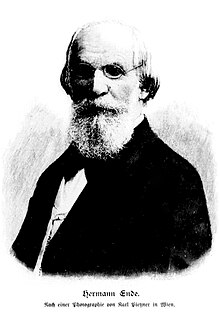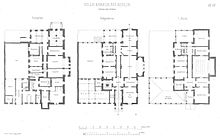Hermann end
Hermann Ende (born March 4, 1829 in Landsberg an der Warthe ; † August 10, 1907 in Wannsee ; full name: Hermann Gustav Louis Ende ) was a German architect and professor at the Technical University (Berlin-) Charlottenburg .
Life
Ende studied at the Berlin Building Academy from 1852 to 1857 . In 1859 he passed the master builder examination. Immediately afterwards he went into business for himself with his partner Wilhelm Böckmann . The architecture office Ende und Böckmann existed until 1895 and was one of the leading offices in Berlin. The Dresden architect Rudolf Schilling also worked there temporarily .
Since 1874, Ende was a member of the Prussian Academy of the Arts . In 1878 he became a professor at the Berlin Building Academy and the Technical University of Charlottenburg . From 1895 to 1904 was the president of the Academy of Arts.
Ende was associated with the Ravené family of merchants . For Louis Fréderic Jacques Ravené he developed the plans for the construction of the ruins of the Reichsburg Cochem . His daughter Martha Helene Wilhelmine married his son Louis Auguste Ravené ; around 1900 he built a villa for the couple in Wannsee.
His brother Louis Ende (1840–1900) was a master builder in Munich.

Hermann Ende died in 1907 at the age of 78 in Wannsee near Berlin. His grave is in the New Wannsee Cemetery . He rests there by the side of his wife Auguste nee. Dickmann-Becker. The dark granite tombstones stand in front of the grave wall of the family burial of Alfred Lent (1836–1915), whom their daughter Gertrud (1865–1945) had married.
plant
Hermann Ende was co-editor of the Architecture Manual . The focus of the work of Ende and Böckmann were villas in the Berlin district of Tiergarten, especially in the diplomatic quarter . Only a few of these buildings survived the Second World War . Furthermore, they planned and established the construction of the Potsdam villa district Neubabelsberg . The various buildings for the Berlin Zoo were also remarkable . Ende and Böckmann erected numerous buildings around the world and at times even had a branch in Japan .
In Japan, they were commissioned to build the Parliament , Justice Department and Supreme Court buildings . The first drafts were rejected by the government in 1889 because they were too Japanese ( Japonism ). According to their plans, however, they were only able to complete the Ministry of Justice and the Court of Justice, while the Parliament received a temporary wooden building and their contract was prematurely terminated in 1890 due to excessive costs.
Buildings and designs
- 1860–1863: Villa von der Heydt in Berlin's Tiergarten district (under monument protection)
- 1864/65: Villa Ende, in Berlin-Tiergarten, Siegmunds Hof 22 (demolished in 1893 and rebuilt in 1892/93 as Villa Gericke in Potsdam in an almost identical copy)
- 1864–1865: Old Synagogue , Elberfeld, Genügsamkeitstraße 33 (rebuilt in 1875, destroyed in 1938)
- 1865–1866, 1875–1876 Grand Hotel de Rome, Berlin, Unter den Linden 10 (demolished in 1910, now Römischer Hof )
- 1867: HF Lehmann bank in Halle (Saale)
- 1871–1874: Building of the Preußische Bodenkreditbank in Berlin, behind the Catholic Church 2
- 1872–1874: Building of the Deutsche Union-Bank in Berlin
- from 1873: various buildings in the Berlin Zoological Garden (e.g. elephant house, antelope house , predator house, music stage)
- 1875: "Oak Castle" for Baron Saint Paul in the Hirschberg Valley (Silesia) near Fischbach ( Karpniki , Poland)
- 1875–1876: Building of the Berlin Architects' Association at Wilhelmstrasse 92/93 (demolished in 1934 for the construction of the Reich Aviation Ministry )
- 1876–1877: Café Bauer in Berlin
- 1881–1885: Museum für Völkerkunde Berlin , Königgrätzer Straße
- 1882: Reconstruction of the Plattner in Gries near Bozen
- 1882–1883: Café Helms in Berlin
- 1883: Estates building in Danzig (today Gdańsk, Poland)
- 1883: Sedan panorama at Berlin Alexanderplatz train station (Panoramastraße)
- 1884: Monkey house in the Berlin Zoological Garden
- 1884–1886: House at Voßstraße 33 in Berlin (later used as the administration building of the Deutsche Reichsbahn)
- 1885: "Schiess'sches Haus" in Magdeburg
- 1887: Great Synagogue in Danzig (today Gdańsk, Poland)
- 1895: Ministry of Justice in Tokyo (Japan)
Honors
On May 2, 1883, he was awarded the medal for services to construction "in silver" and in 1891 the order Pour le Mérite (peace class) .
Ende's grave in the New Wannsee Cemetery was dedicated as an honorary grave for the State of Berlin from 1990 to 2014 .
The end street in Berlin-Wannsee is named after him.
literature
- Additional entry in Julius Posener, Regine Sonntag: Muthesius, Hermann. In: New German Biography (NDB). Volume 18, Duncker & Humblot, Berlin 1997, ISBN 3-428-00199-0 , p. 652 ( digitized version ).
- Anonymous: Hermann Ende. For the seventieth birthday. In: Berliner Architekturwelt , No. 12 (1899), pp. 421–422.
- Franziska Pagel: Ende & Böckmann. A Berlin architecture firm in the 19th century , Berlin: Gebr. Mann Verlag 2019, ISBN 978-3-7861-2814-4 .
Web links
- Literature by and about Hermann Ende in the catalog of the German National Library
- Kathrin Chod, Herbert Schwenk, Hainer Weisspflug: Hermann Ende . In: Hans-Jürgen Mende , Kurt Wernicke (ed.): Berliner Bezirkslexikon, Mitte . Luisenstadt educational association . Haude and Spener / Edition Luisenstadt, Berlin 2003, ISBN 3-89542-111-1 ( luise-berlin.de - as of October 7, 2009).
- Hermann end. In: arch INFORM .
- Old Justice Department Tokyo photo gallery
- Hermann end. For his seventieth birthday (March 4, 1899). In: Berliner Architekturwelt , 1899.
Individual evidence
- ↑ Photos of the family villa in Wannsee: architekturmuseum.ub.tu-berlin.de panels 3 and 4 in the architecture museum of the Technical University of Berlin - Hermann Rückwardt: New villas in the area around Berlin .
- ^ Hans-Jürgen Mende : Lexicon of Berlin burial places . Pharus-Plan, Berlin 2018, ISBN 978-3-86514-206-1 . P. 659.
- ↑ Dallas Finn: Reassessing the Rokumeikan . In: Ellen P. Conant (Ed.): Challenging Past and Present. The Metamorphosis of Nineteenth-century Japanese Art . University of Hawaii Press, 2006, ISBN 978-0-8248-2937-7 , pp. 235 ( Google Books ).
- ^ Ende & Böckmann Architect: Music stage in the zoological garden near Berlin . (Sting). In: Architectural Sketchbook . tape 1874 , issue 6 (whole series of issue 129). Ernst & Korn, Berlin, p. 6 ( archive.org - Internet Archive [accessed March 28, 2020]).
- ↑ Armorer with Park. South Tyrolean monument browser
- ↑ Monkey House. In: Centralblatt der Bauverwaltung , No. 31, August 2, 1884, p. 320; accessed on December 31, 2012
- ↑ Honor. In: Centralblatt der Bauverwaltung , No. 19, May 12, 1883, p. 167; Retrieved December 21, 2012
- ↑ The Order Pour le Mérite FOR SCIENCE AND ARTS (PDF; 352 kB), accessed on December 21, 2012
- ↑ Endestrasse. In: Street name lexicon of the Luisenstädtischer Bildungsverein (near Kaupert )
| personal data | |
|---|---|
| SURNAME | End, Hermann |
| ALTERNATIVE NAMES | Ende, Hermann Gustav Louis (full name) |
| BRIEF DESCRIPTION | German architect |
| DATE OF BIRTH | March 4, 1829 |
| PLACE OF BIRTH | Landsberg (Warta) |
| DATE OF DEATH | August 10, 1907 |
| Place of death | Wannsee |





